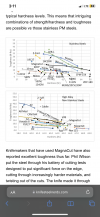scdub
Basic Member
- Joined
- May 29, 2004
- Messages
- 2,945
So then, no.Yes, the only steels that beat it have significantly lower wear resistance
(Again - just talking about toughness - not in relation to wear resistance…)
The BladeForums.com 2024 Traditional Knife is ready to order! See this thread for details:
https://www.bladeforums.com/threads/bladeforums-2024-traditional-knife.2003187/
Price is $300 ea (shipped within CONUS). If you live outside the US, I will contact you after your order for extra shipping charges.
Order here: https://www.bladeforums.com/help/2024-traditional/ - Order as many as you like, we have plenty.
So then, no.Yes, the only steels that beat it have significantly lower wear resistance
They should have named it ABLE !AEBL for almost anything
So then, no.
yeah, it's Worst feature is it's name!!!They should have named it ABLE !
In the following (edge retention vs. toughness, from knifesteelnerds.com / Larrin), the blue steels are stainless, the orange ones carbon. You move your eye right, you get harder steels, or up, and you get tougher steels with less hardness.

The orange curve shows you "best in class" knife steels, wrt to edge retention vs. toughness tradeoff. Except for Magnacut, they are all carbon steels, non-stainless.
Good toughness doesn't only mean less prone to catastrophic failure, but more importantly, less chipping.
For example, you want a to pick the most wear resistant steel at good toughness ? You should pick Maxamet or Rex 121 (both carbon steels, non-stainless).
I don't see AEBL, labeled on the chart . Where would it fall , compared to 3V , for example ?There's a reason I make AEBL choppers and swords.
AEBL would be the leftmost blue dot, so same toughness as 3V.I don't see AEBL, labeled on the chart . Where would it fall , compared to 3V , for example ?
AEBL would be the leftmost blue dot, so same toughness as 3V.
Thanks !AEBL would be the leftmost blue dot, so same toughness as 3V.

AEBL is still pretty tough at high hardness, 3V dropsThanks !
So lower ER for AEBL , at same toughness . By the chart .
3V still better it appears ? Except less stainless .
I don't see that reflected on the chart for ER . But I might be missing something ?AEBL is nearly 8 ft lbs tougher at 60-61 RC than 3V at the same hardness
According to Larrin's data, 3V is 30-35 ft-lbs in that range and AEBL is 33-38. He has one outlier result in that range showing 41, so maybe that's what you're referring to.AEBL is nearly 8 ft lbs tougher at 60-61 RC than 3V at the same hardness
That's very true what you said...... Run AEB-L @64, and run 3V @64 and you will notice big differencesI like AEB-L too. I've tried AEB-L and 3V from 2 makers who use both, and do like 3V from either even more, unless I cut a lemon or such
Note that the terms hardness and edge retention in the above charts are not fully interchangeable.
If I asked you , I'd trust your judgment and experience ! As always .asking me for big blades in 3V that they should choose AEBL instead
